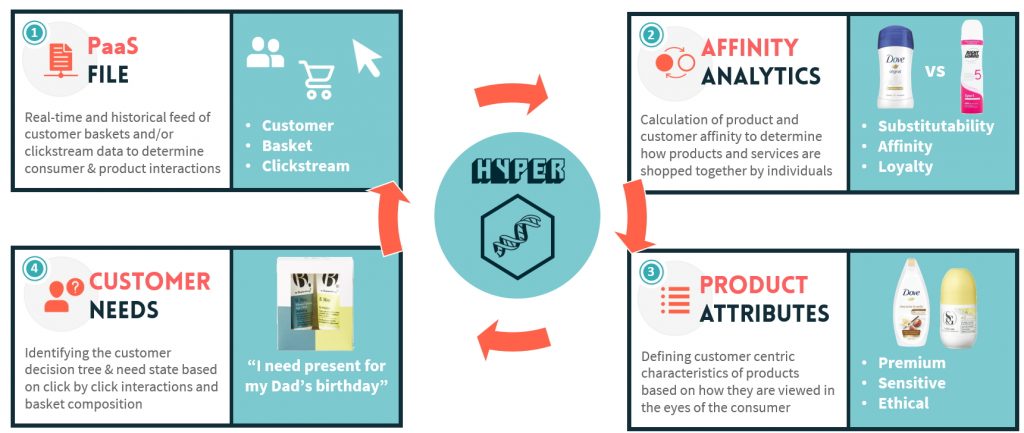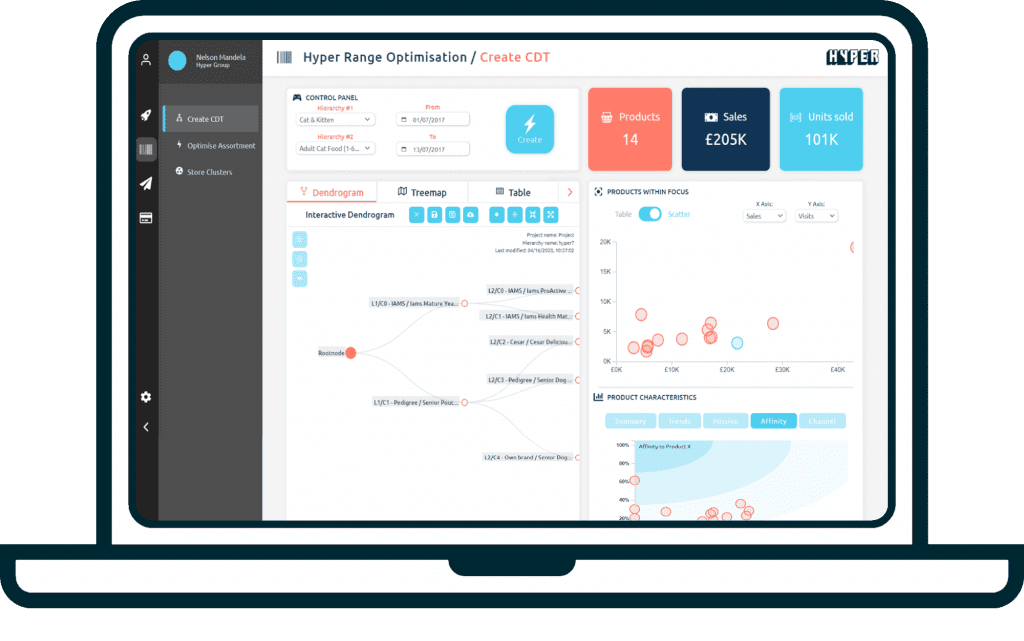
Don’t believe the hype…
Data driven, data led, big data, data science, algorithmic…the list of over-hyped, grandiose terms for using data to improve business performance grows longer by the year.
For all the column inches devoted to this topic, you’d be forgiven for believing that it’s now commonplace for businesses to be routinely using data to support key decisions.
So, does reality match perception? And if not, what practical steps can businesses take to become truly data driven?

Image by Suad Kamardeen on Unsplash
A short history lesson.

Consumer data has long been used for specific business purposes. In fact, Wikipedia tells us “the word “data” was first used to mean “transmissible and storable computer information” in 1946”. Among the many examples of businesses successfully using data, Tesco are rightly cited as an early pioneer, using it to understand customer behaviour, with a very visible use case of delivering relevant offers to Clubcard holders.
Our own experience dates to the early 2000s when we were using data to help clients understand their customers, typically with the goal deploying personalised direct marketing activity.
Three key changes have occurred over recent years that have established data as a critical focus area for businesses.
- An abundance of data created by the world going digital. According to g2.com, 2 quintillion bytes (that’s 18 zeros) of data are created daily
- Accessible high-performance data storage, processing and analytics tools, epitomised by cloud computing
- We now have exemplars; some of the world’s leading companies succeed because of how they use data, such as Google, Amazon and Netflix
Reality bites.

Image by Martin Sanchez on Unsplash
Businesses that successfully use data are proven to be more profitable than their counterparts who work on gut instinct alone.
Entrepreneur.com report that “businesses that use big data saw a profit increase of 8–10 percent and a 10 percent reduction in overall cost.”
And as far back as 2016 Netflix exclaimed that “the combined effect of personalisation and recommendations save us more than $1B per year.”
Although the value created by using data effectively is widely acknowledged, experience tells us that many businesses are some way from realising the benefits. Deloitte report that “fewer than four in 10 (37 percent) executives place their companies in the top two categories of the Deloitte Insight Driven Organisation maturity scale.”
Significant untapped potential can be found across multiple business areas, including marketing, customer experience and operations.
Data to anything.
Opportunity abounds for smart companies to use data right across the enterprise, such as creating supply chain efficiencies, guiding new product development and predictive maintenance of equipment.
This blog would be endless if we covered them all, so here we focus on 3 interlinked use cases which impact a business’s most important asset, it’s customers.
Offering the Right Product Range
How often do we hear companies claiming to be customer centric? Yes, their intentions are good and elements of their offering, such as customer services, are geared towards resolving customer queries. But true customer focus should go far beyond this, starting with making customer led decisions about what products to sell.
Traditionally companies choose what to sell based on the knowledge of a buying and merchandising team, skilled at trading and securing the best purchase price. Often these decisions are guided by available space on shelves, in warehouses or the number of pages on a website or in a physical catalogue.
With data, businesses can use techniques such as affinity analytics to truly understand the relationships between people and the products they buy, helping determine to what extent products are substitutable or complimentary. This approach is enhanced by understanding product attributes, as viewed by customers, for example ‘premium’ or ‘ethical’, to help build balanced and desirable product ranges.
A further step is to create customer need states, for example ‘I’m shopping for my Dad’s birthday present’, enabling personalised product recommendations and bundles.

Empowering buying and merchandising teams with insights from these types of analytics helps to offer a product range that is informed by customer preferences and made up of complimentary products, with an appropriate selection for each customer need state.
Optimising Margins through Intelligent Pricing
Having created customer need states, data can be used to better understand price elasticity within them. Which products must be priced competitively, at the expense of margin, in order to gain market share? And which are sufficiently elastic to increase the price and generate greater profit?
This method offers a smarter alternative than simply working to a price gap vs competitors or varying price dependent on inventory levels.
Hyper Personalisation

Image by Marco Chilese on Unsplash
Having used data to understand what, when and how customers buy products, then attributes to describe both customers and products, data-driven personalisation is now possible.
Hyper-personalisation refers to serving highly relevant, useful and enjoyable interactions with individual customers, based on what you know about them and their preferences. Data enables significantly improved targeted marketing, promotions and problem solving via customer services to name just a few.
The rewards for those that get this right are clear. McKinsey report that “83 percent of customers say they want their shopping experience to be personalised in some way, and our research suggests that effective personalisation can increase store revenues by 20 to 30 percent.”
Although personalisation of websites to individuals is commonplace, extending this across all other points of interaction with customers is rare. Personalising customer experiences in physical locations could offer rich rewards. Giving customers a reason to securely share data in exchange for clear benefits is key, be that discounts on products, tailored recommendations or ways to make their lives easier or more enjoyable. The greater the customer knowledge gained, the more you can tailor their experience.
What’s stopping you from becoming data driven?
If the perception of companies successfully using data isn’t matching reality, what are the root causes?
Change is HARD!
For most business leaders, data wasn’t a ‘thing’ when they were establishing their careers. They are required to first learn the fundamentals of data, the discipline of data science and strands of AI, such as machine learning, then work out how to apply them to improve their business and finally to implement data led transformation. This is not straight forward.
Business leaders need to be voracious learners, understand how to formulate and implement strategies and have strong people skills to communicate and successfully apply their vision for data led change.
Often, they turn to specialist agencies to help, enabling the development a digital transformation market which Market & Markets expect to grow to $665 billion by 2023.
Slow & Subjective Decision Making
By their very nature, large businesses tend to be complex, often with teams organised around particular disciplines, for example marketing, category management and supply chain. Even within these teams’ silos exist. A marketing team is often split into ecommerce and physical and category management split across various product types.
Decisions are made by committee, fall to the highest ranked person, or worst still, no decision is made for fear of upsetting people in another team.
Access to Talent
True data science talent is a scarce and valuable commodity. People with the ability to code, problem solve and communicate effectively with others are worth their weight in gold. Despite many businesses claiming to offer this type of role, our experience is that those occupying the position typically lack one of more of these vital skills.
A movement is afoot to democratise data science, aimed at removing the high technical barrier to entry. Businesses offering accessible tools which carry out much of the hard work of data processing, engineering, analytics and visualisation are well worth seeking out, particularly where their platform is built to address your specific business need.
Solving the puzzle.
The good news is that success in becoming a data driven business is attainable. Below are a few key principles to follow.
Customers are Your North Star
Most businesses claim to be customer centric, but as with those stating they’re driven by data, the truth is somewhat different. Still, organising your business around the customer is a fine principle to follow and, when done successfully, yields fantastic results. Harvard Business Review report that “customers who had the best past experiences spend 140% more compared to those who had the poorest past experience.”
In practical terms this means becoming customer first with every decision you make. Understand what’s important to them, what they value in yours and your competitors’ offerings and analyse signals from their interactions with you. Then use the insights created to deliver products and services they desire in a way they wish to receive them.
The first step is to deliver data capability that can be both used to deliver customer centric experiences and consumed to demonstrate the impact of those decisions. The outputs of affinity analytics enable this, creating simple customer metrics that businesses can get behind in order to drive customer satisfaction through relevance and enjoyable interactions.
I won’t bore you with the technical details here, but simply leveraging data and identifying shopper needs can help businesses quickly carry out a health check on which customer missions they are delivering against, and where they are letting people down.
This requires organisations to break silos. Create teams with relevant skillsets to solve customer problems, not because it suits you as a business. This could mean combining strategists, data scientists, marketers and project managers, all unified around a customer focused goal.
These teams should be kept small too. Jeff Bezos famously told employees that if a team can’t be fed with two pizzas it’s too large. A tight knit and motivated group, with a clear remit, and the skills to address it, can be very powerful.
Make Insight Accessible
Whether your data scientists are your own employees, or you work with a specialist agency, for your business to really adopt and reap the benefits from data, the insight created needs to be accessible to all.
This means clearly articulating the nuggets from your analysis in easily understandable language and sharing insight through user friendly tools, such as interactive dashboards.

Businesses who have cracked this manage to move from their data science team resembling an A&E department, answering the same urgent queries time after time, to one that enables self-serve answers to common questions whilst focusing on more challenging and higher value problem solving.
Communicate Effectively
Communication is one of the most important tools in anyone’s armoury. Yet it’s woefully used by many.

Photo by Jason Rosewell on Unsplash
People have an innate need to be included and heard in their organisation, meaning effective communication to solicit their views and to feed back progress of data led initiatives is imperative.
Clearly articulating your organisation’s plans for using data helps get everyone on the same page. What problems will it be used to solve, which opportunities will it help realise and what risks will it help mitigate? Giving this context helps the necessary people understand the business value that stands to be realised.
Delivering value incrementally and telling people about it helps keep engagement and momentum. Using hard and soft measures to quantify success drives communication home and creates a willingness to hear more.
Many data focused people are left brain dominant, meaning they excel at logic, maths and linear thinking. Where they often struggle is with language, communication and feeling. It’s therefore key for others to act as data translators, helping extract and spread the gems wisdom to the people that need to know.
Final thoughts.
Despite what you read, using data to improve business performance is still an area of vast untapped potential. Yes, there are notable success stories, but the majority still have some way to go.
The great news is that the possibilities are huge for applying data and analytics across almost any area of a business to improve it.
To succeed it’s critical to address the blockers, which often means making difficult organisational decisions, freeing up the resources needed and organising teams in a way that allows them to succeed.
It means truly and deeply focusing on customers, not just including it in your mission statement. It also requires you to make data, analytics and insight accessible to all, not just the preserve of those skilled in writing code.
Data driven affinity solutions can be easy to deploy, and provide the tools and insight required for a business to become customer centric, if the business aligns to deliver against customer needs.
Finally, communication is key. Bring people on the journey with you, give them a sense of ownership and participation, and regularly feedback on what’s gone well, with tangible measures of success.
If you have any other tips for transforming into a data driven business, please comment below. Also if you want to receive notifications of our latest news and thinking, please subscribe below.
Visit HyperFinity Get In Touch



Join the discussion One Comment